[English] 日本語
 Yorodumi
Yorodumi- PDB-1c1y: CRYSTAL STRUCTURE OF RAP.GMPPNP IN COMPLEX WITH THE RAS-BINDING-D... -
+ Open data
Open data
- Basic information
Basic information
| Entry | Database: PDB / ID: 1c1y | ||||||
|---|---|---|---|---|---|---|---|
| Title | CRYSTAL STRUCTURE OF RAP.GMPPNP IN COMPLEX WITH THE RAS-BINDING-DOMAIN OF C-RAF1 KINASE (RAFRBD). | ||||||
 Components Components |
| ||||||
 Keywords Keywords | SIGNALING PROTEIN / GTP-BINDING PROTEINS / PROTEIN-PROTEIN COMPLEX / EFFECTORS | ||||||
| Function / homology |  Function and homology information Function and homology informationpositive regulation of Fc receptor mediated stimulatory signaling pathway / Rap protein signal transduction / death-inducing signaling complex assembly / regulation of cell junction assembly / response to antineoplastic agent / nerve growth factor signaling pathway / intermediate filament cytoskeleton organization / negative regulation of collagen biosynthetic process / positive regulation of vasculogenesis / negative regulation of synaptic vesicle exocytosis ...positive regulation of Fc receptor mediated stimulatory signaling pathway / Rap protein signal transduction / death-inducing signaling complex assembly / regulation of cell junction assembly / response to antineoplastic agent / nerve growth factor signaling pathway / intermediate filament cytoskeleton organization / negative regulation of collagen biosynthetic process / positive regulation of vasculogenesis / negative regulation of synaptic vesicle exocytosis / guanyl-nucleotide exchange factor complex / regulation of Rho protein signal transduction / ARMS-mediated activation / type B pancreatic cell proliferation / SHOC2 M1731 mutant abolishes MRAS complex function / Gain-of-function MRAS complexes activate RAF signaling / Rap1 signalling / response to carbohydrate / establishment of endothelial barrier / MET activates RAP1 and RAC1 / insulin secretion involved in cellular response to glucose stimulus / anchoring junction / Negative feedback regulation of MAPK pathway / IFNG signaling activates MAPKs / Frs2-mediated activation / GP1b-IX-V activation signalling / p130Cas linkage to MAPK signaling for integrins / ERBB2-ERBB3 signaling pathway / neurotrophin TRK receptor signaling pathway / regulation of neurotransmitter receptor localization to postsynaptic specialization membrane / face development / pseudopodium / GRB2:SOS provides linkage to MAPK signaling for Integrins / regulation of cell differentiation / positive regulation of protein kinase activity / thyroid gland development / synaptic vesicle exocytosis / extrinsic apoptotic signaling pathway via death domain receptors / somatic stem cell population maintenance / positive regulation of peptidyl-serine phosphorylation / positive regulation of GTPase activity / MAP kinase kinase kinase activity / type II interferon-mediated signaling pathway / Schwann cell development / negative regulation of protein-containing complex assembly / negative regulation of extrinsic apoptotic signaling pathway via death domain receptors / specific granule membrane / phagocytic vesicle / response to muscle stretch / sperm midpiece / Integrin signaling / myelination / CD209 (DC-SIGN) signaling / liver regeneration / insulin-like growth factor receptor signaling pathway / guanyl-nucleotide exchange factor activity / positive regulation of phagocytosis / thymus development / cellular response to cAMP / adenylate cyclase activator activity / small monomeric GTPase / positive regulation of D-glucose import across plasma membrane / protein localization to plasma membrane / wound healing / RAF activation / Signaling by high-kinase activity BRAF mutants / positive regulation of neuron projection development / cellular response to nerve growth factor stimulus / MAP2K and MAPK activation / small GTPase binding / Stimuli-sensing channels / cellular response to xenobiotic stimulus / Negative regulation of MAPK pathway / Signaling by RAF1 mutants / Signaling by moderate kinase activity BRAF mutants / Paradoxical activation of RAF signaling by kinase inactive BRAF / Signaling downstream of RAS mutants / GDP binding / Signaling by BRAF and RAF1 fusions / cell junction / Glucagon-like Peptide-1 (GLP1) regulates insulin secretion / insulin receptor signaling pathway / late endosome / nervous system development / MAPK cascade / presynapse / G protein activity / regulation of apoptotic process / early endosome / mitochondrial outer membrane / protein phosphorylation / positive regulation of ERK1 and ERK2 cascade / non-specific serine/threonine protein kinase / protein kinase activity / positive regulation of MAPK cascade / neuron projection / endosome membrane / negative regulation of cell population proliferation / protein serine kinase activity / protein serine/threonine kinase activity Similarity search - Function | ||||||
| Biological species |  Homo sapiens (human) Homo sapiens (human) | ||||||
| Method |  X-RAY DIFFRACTION / X-RAY DIFFRACTION /  SYNCHROTRON / Resolution: 1.9 Å SYNCHROTRON / Resolution: 1.9 Å | ||||||
 Authors Authors | Nassar, N. | ||||||
 Citation Citation |  Journal: Nature / Year: 1995 Journal: Nature / Year: 1995Title: The 2.2 A crystal structure of the Ras-binding domain of the serine/threonine kinase c-Raf1 in complex with Rap1A and a GTP analogue. Authors: Nassar, N. #1:  Journal: Nat.Struct.Biol. / Year: 1996 Journal: Nat.Struct.Biol. / Year: 1996Title: Ras/Rap effector specificty determined by charge reversal. Authors: Nassar, N. #2:  Journal: Nature / Year: 2008 Journal: Nature / Year: 2008Title: Structure of Epac2 in complex with a cyclic AMP analogue and RAP1B. Authors: Holger Rehmann / Ernesto Arias-Palomo / Michael A Hadders / Frank Schwede / Oscar Llorca / Johannes L Bos /  Abstract: Epac proteins are activated by binding of the second messenger cAMP and then act as guanine nucleotide exchange factors for Rap proteins. The Epac proteins are involved in the regulation of cell ...Epac proteins are activated by binding of the second messenger cAMP and then act as guanine nucleotide exchange factors for Rap proteins. The Epac proteins are involved in the regulation of cell adhesion and insulin secretion. Here we have determined the structure of Epac2 in complex with a cAMP analogue (Sp-cAMPS) and RAP1B by X-ray crystallography and single particle electron microscopy. The structure represents the cAMP activated state of the Epac2 protein with the RAP1B protein trapped in the course of the exchange reaction. Comparison with the inactive conformation reveals that cAMP binding causes conformational changes that allow the cyclic nucleotide binding domain to swing from a position blocking the Rap binding site towards a docking site at the Ras exchange motif domain. | ||||||
| History |
|
- Structure visualization
Structure visualization
| Structure viewer | Molecule:  Molmil Molmil Jmol/JSmol Jmol/JSmol |
|---|
- Downloads & links
Downloads & links
- Download
Download
| PDBx/mmCIF format |  1c1y.cif.gz 1c1y.cif.gz | 67.9 KB | Display |  PDBx/mmCIF format PDBx/mmCIF format |
|---|---|---|---|---|
| PDB format |  pdb1c1y.ent.gz pdb1c1y.ent.gz | 49.3 KB | Display |  PDB format PDB format |
| PDBx/mmJSON format |  1c1y.json.gz 1c1y.json.gz | Tree view |  PDBx/mmJSON format PDBx/mmJSON format | |
| Others |  Other downloads Other downloads |
-Validation report
| Summary document |  1c1y_validation.pdf.gz 1c1y_validation.pdf.gz | 455.7 KB | Display |  wwPDB validaton report wwPDB validaton report |
|---|---|---|---|---|
| Full document |  1c1y_full_validation.pdf.gz 1c1y_full_validation.pdf.gz | 456.5 KB | Display | |
| Data in XML |  1c1y_validation.xml.gz 1c1y_validation.xml.gz | 6.8 KB | Display | |
| Data in CIF |  1c1y_validation.cif.gz 1c1y_validation.cif.gz | 10.2 KB | Display | |
| Arichive directory |  https://data.pdbj.org/pub/pdb/validation_reports/c1/1c1y https://data.pdbj.org/pub/pdb/validation_reports/c1/1c1y ftp://data.pdbj.org/pub/pdb/validation_reports/c1/1c1y ftp://data.pdbj.org/pub/pdb/validation_reports/c1/1c1y | HTTPS FTP |
-Related structure data
| Related structure data | |
|---|---|
| Similar structure data |
- Links
Links
- Assembly
Assembly
| Deposited unit | 
| ||||||||
|---|---|---|---|---|---|---|---|---|---|
| 1 |
| ||||||||
| Unit cell |
|
- Components
Components
-Protein , 2 types, 2 molecules AB
| #1: Protein | Mass: 19055.641 Da / Num. of mol.: 1 / Fragment: RAP, RESIDUES 1-167 Source method: isolated from a genetically manipulated source Source: (gene. exp.)  Homo sapiens (human) / Plasmid: PBKS / Production host: Homo sapiens (human) / Plasmid: PBKS / Production host:  |
|---|---|
| #2: Protein | Mass: 8789.290 Da / Num. of mol.: 1 / Fragment: RAFRBD, RESIDUES 51-131 Source method: isolated from a genetically manipulated source Source: (gene. exp.)  Homo sapiens (human) / Plasmid: PGEX-2T / Production host: Homo sapiens (human) / Plasmid: PGEX-2T / Production host:  References: UniProt: P04049, Transferases; Transferring phosphorus-containing groups; Phosphotransferases with an alcohol group as acceptor |
-Non-polymers , 4 types, 86 molecules 






| #3: Chemical | ChemComp-MG / |
|---|---|
| #4: Chemical | ChemComp-GTP / |
| #5: Chemical | ChemComp-CA / |
| #6: Water | ChemComp-HOH / |
-Experimental details
-Experiment
| Experiment | Method:  X-RAY DIFFRACTION / Number of used crystals: 1 X-RAY DIFFRACTION / Number of used crystals: 1 |
|---|
- Sample preparation
Sample preparation
| Crystal | Density Matthews: 2.86 Å3/Da / Density % sol: 56.93 % | ||||||||||||||||||||||||||||||||||||||||||||||||||||||||||||||||||||||||||||||||||||
|---|---|---|---|---|---|---|---|---|---|---|---|---|---|---|---|---|---|---|---|---|---|---|---|---|---|---|---|---|---|---|---|---|---|---|---|---|---|---|---|---|---|---|---|---|---|---|---|---|---|---|---|---|---|---|---|---|---|---|---|---|---|---|---|---|---|---|---|---|---|---|---|---|---|---|---|---|---|---|---|---|---|---|---|---|---|
| Crystal grow | Temperature: 300 K / Method: vapor diffusion, hanging drop / pH: 7.6 Details: mmePeg5000, magnesium chloride, calcium chloride, ammonium sulphate., pH 7.6, VAPOR DIFFUSION, HANGING DROP, temperature 300K | ||||||||||||||||||||||||||||||||||||||||||||||||||||||||||||||||||||||||||||||||||||
| Crystal grow | *PLUS | ||||||||||||||||||||||||||||||||||||||||||||||||||||||||||||||||||||||||||||||||||||
| Components of the solutions | *PLUS
|
-Data collection
| Diffraction | Mean temperature: 278 K |
|---|---|
| Diffraction source | Source:  SYNCHROTRON / Site: SYNCHROTRON / Site:  EMBL/DESY, HAMBURG EMBL/DESY, HAMBURG  / Beamline: BW7B / Wavelength: 0.87 / Beamline: BW7B / Wavelength: 0.87 |
| Detector | Type: MARRESEARCH / Detector: IMAGE PLATE / Date: Sep 13, 1994 |
| Radiation | Protocol: SINGLE WAVELENGTH / Monochromatic (M) / Laue (L): M / Scattering type: x-ray |
| Radiation wavelength | Wavelength: 0.87 Å / Relative weight: 1 |
| Reflection | Resolution: 1.9→20 Å / Num. all: 24787 / Num. obs: 24787 / % possible obs: 98 % / Observed criterion σ(I): 2 / Redundancy: 4.3 % / Biso Wilson estimate: 24.2 Å2 / Rmerge(I) obs: 0.038 / Net I/σ(I): 12 |
| Reflection shell | Resolution: 1.9→2.02 Å / Redundancy: 3 % / Rmerge(I) obs: 0.325 / Num. unique all: 3569 / % possible all: 93.6 |
| Reflection | *PLUS % possible obs: 98 % |
- Processing
Processing
| Software |
| ||||||||||||||||||||||||||||||||||||||||
|---|---|---|---|---|---|---|---|---|---|---|---|---|---|---|---|---|---|---|---|---|---|---|---|---|---|---|---|---|---|---|---|---|---|---|---|---|---|---|---|---|---|
| Refinement | Resolution: 1.9→20 Å / Rfactor Rfree error: 0.005 / Data cutoff high absF: 7734287.57 / Data cutoff low absF: 0 / Isotropic thermal model: RESTRAINED / Cross valid method: THROUGHOUT / σ(F): 0 / Stereochemistry target values: Engh & Huber / Details: Maximum Likelyhood refinement using CNS_0.4.
| ||||||||||||||||||||||||||||||||||||||||
| Solvent computation | Solvent model: FLAT MODEL / Bsol: 37.03 Å2 / ksol: 0.332 e/Å3 | ||||||||||||||||||||||||||||||||||||||||
| Displacement parameters | Biso mean: 38.8 Å2
| ||||||||||||||||||||||||||||||||||||||||
| Refine analyze |
| ||||||||||||||||||||||||||||||||||||||||
| Refinement step | Cycle: LAST / Resolution: 1.9→20 Å
| ||||||||||||||||||||||||||||||||||||||||
| Refine LS restraints |
| ||||||||||||||||||||||||||||||||||||||||
| LS refinement shell | Resolution: 1.9→2.02 Å / Rfactor Rfree error: 0.019 / Total num. of bins used: 6
| ||||||||||||||||||||||||||||||||||||||||
| Xplor file |
| ||||||||||||||||||||||||||||||||||||||||
| Software | *PLUS Name: CNS / Version: 0.4 / Classification: refinement | ||||||||||||||||||||||||||||||||||||||||
| Refinement | *PLUS σ(F): 0 / % reflection Rfree: 9.9 % | ||||||||||||||||||||||||||||||||||||||||
| Solvent computation | *PLUS | ||||||||||||||||||||||||||||||||||||||||
| Displacement parameters | *PLUS Biso mean: 38.8 Å2 | ||||||||||||||||||||||||||||||||||||||||
| Refine LS restraints | *PLUS
| ||||||||||||||||||||||||||||||||||||||||
| LS refinement shell | *PLUS Rfactor Rfree: 0.38 / % reflection Rfree: 9.9 % / Rfactor Rwork: 0.357 |
 Movie
Movie Controller
Controller




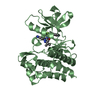

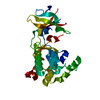
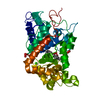
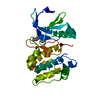
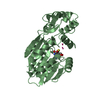



 PDBj
PDBj



















